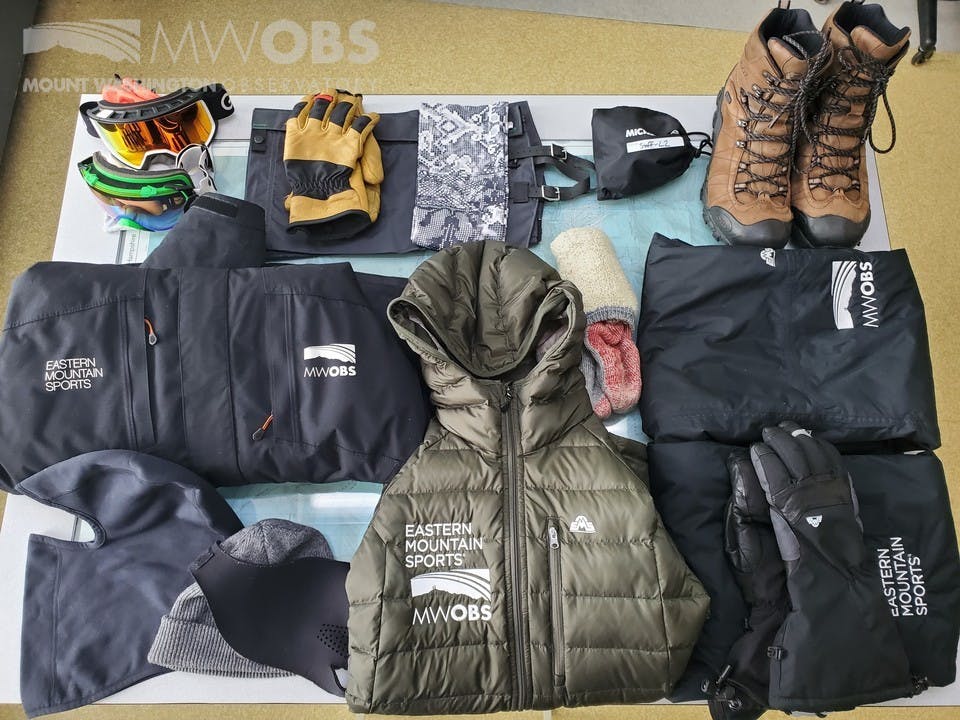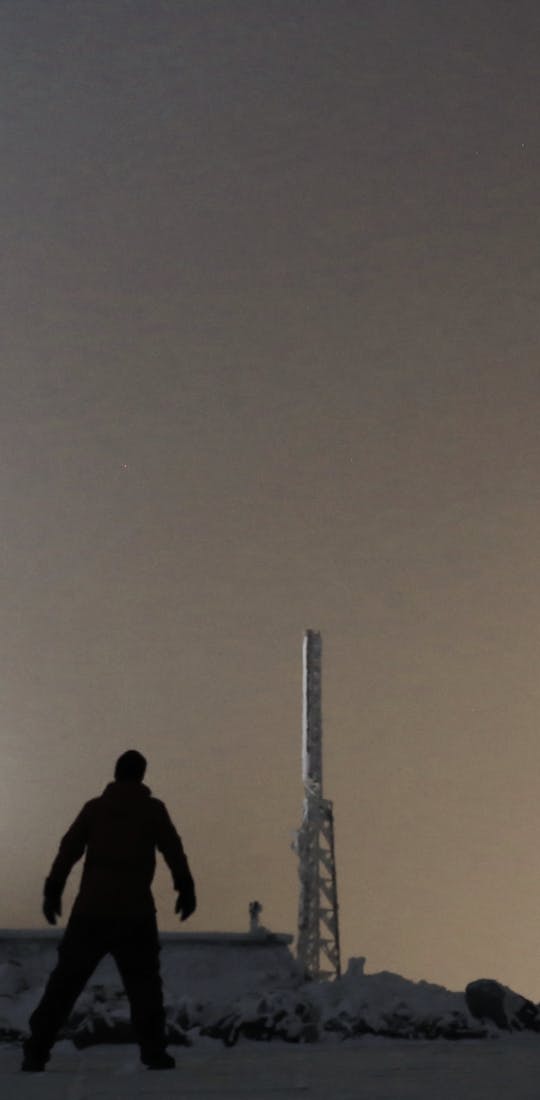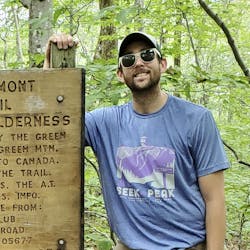Preparing for any kind of outdoor activity involves forethought and research, and that is especially true in the winter.
In this piece, we are going to discuss why it is imperative to be prepared, how to prepare for time spent outdoors in the winter elements, and a little bit on what we do to prepare. The Mount Washington Observatory (MWObs) is supported by not only our wonderful members, but also by our partners over at Eastern Mountain Sports and Oboz Footwear. They supply us with most of the gear we need to stay warm and dry in some of the world’s worst weather. Closer to the end of the article, we will go through some of the gear we like to use up on the summit of Mount Washington and how it helps us stay warm.
Check the weather
Whether we notice it or not, we go through a thought process of what we might encounter outdoors. This process changes depending on the activity, but regardless, it happens whether you are running out to get the mail in the rain, working outside in the elements, skiing/snowboarding, going for a day hike, camping out, or heading out for a multi-day thru-hike. Some of us may run out to get the mail in the rain or pump gas in the cold without protective gear, and do not really care because the safety of warmth and dryness is only a minute away. Then there are those of us who put our rain jacket and gloves on.
When spending time outdoors in the elements for a long period WITHOUT the comfort of somewhere to warm up and dry off, or store your food and water somewhere, then it is up to you to be capable of doing so. We need to think about the items we will need in order to have access to the necessities, such as water, food, and shelter (protective equipment/clothing), and any tools or gear required to overcome any struggle or discomfort. Most of the challenging situations in the outdoors come from the weather, but what costs people their lives in the outdoors is unfortunately, a lack of planning, preparedness, and possibly, poor risk management. Pending some catastrophic injury that results in a rather quick death, a majority of life loss that has occurred could have been prevented. Therefore, that brings me to the first thing we should do when preparing, assuming we know where we are going: check the weather.
In the summer, we do not have to think about it too much because the temperatures are warm and the weather is generally favorable. We still ask ourselves several questions, like is it going to rain or not? Are thunderstorms a possibility? How hot or cool it will be? How windy will it be? These questions then inform how we should prepare. In the winter, these questions become more specific and numerous because the conditions in the winter are vastly different and arguably, much harsher. Where can we check the weather? There are many resources to check the weather. The local National Weather Service along with the local weather station are some of the best resources to use. When using the National Weather Service, be sure to read their forecast discussion. While forecasts may not verify for a number of reasons, the forecast discussion will explain what should happen and what could happen in detail. Therefore, even if the forecast does not turn out, we will still be aware of other possibilities, which is very important when it comes to the gear we would pack. If you are in the White Mountains of New Hampshire, we should also check out the Mount Washington Observatory’s forecast and discussion.
MWObs puts out two forecasts a day, one in the morning before the start of the day and another at the end of the day. Each forecast is for the following 48-hour period, where we specifically focus on the weather's effects on the White Mountains. The intent of the forecasts is to provide recreationists in the White Mountains with the necessary weather information and guidance to prepare for time spent outdoors. Many forecasts available to the public span a large area and oftentimes local conditions create microclimates that may cause the weather to be different from the other side of town or on one side of the mountain versus the other. One solution to this is having a weather app on your phone that pinpoints your location and tells you what the weather is and will be. An algorithm that incorporates proprietary information and model outputs to produce a local forecast commonly produces these types of forecasts. These have potential and should also be consulted, but currently lack the resolution and dynamics to verify better than a human's ability to apply conceptual thinking to model outputs, especially in boundary zones such as mountainous and coastal regions.
MWObs’s forecasts are only for the White Mountains. If you are elsewhere wanting to enjoy the outdoors, there may be an organization that produces similar forecast products, so be sure to look around on the internet.
Tell someone your plan
Once we know what the weather should be like, what weather could occur, and have decided on going, we then communicate. We understand hiking and adventuring alone can be exciting, freeing, and good for our confidence. I enjoy it myself, but realize that it puts us at an increased level of danger. If anything negative were to happen, having another person or more with you will increase your comfort and chances of survival. If you do decide to go it alone, tell your family and friends what you are doing and where you are going; tell at least one person. Tell them where you are leaving from and at what time. Tell them where you will be going, where you will end, and at what time. This way, if anything happens and you do not show up when you meant to, it does not go unnoticed. If people are with you and something happens, then communication is much faster. Thanks to technology, we now have devices that can track us via GPS and send a signal at pre-determined time intervals to the people you designate. There are also other types of GPS trackers out there as well. Any of these are great to have on your person in case of emergency, especially when you are somewhere without cell service.
Start packing
Now that we know where we are going, we have looked at the weather and decided it is safe to go, and we have told people of our plans, the next thing to do is start packing. In the winter, numerous weather events that can put a damper on your outdoor adventure. Someone very wise told me once at young age “if you bring a rain jacket, it will never rain on you.” I did not quite understand what this person meant for probably several years, but once I smartened up, I realized that yes, just because you bring a jacket does not mean it is not raining, but it does mean that the rain should not affect you because you brought a rain jacket to keep the rain off you. This same person told me “if you are standing next to the fire to stay warm, then you are not dressed properly.” Over the years, we learn a lot from our mistakes, and I have made a lot of them when it comes to winter activities, so let’s go through some of the things we do here at the Observatory and during other winter activities to stay warm, dry and safe with our EMS and Oboz gear.
The main thing we want to focus on when preparing is to make sure we can stay dry and warm. To stay dry, we need to keep the moisture on the outside from getting to our bodies or inner clothing. We also need to stay dry on the inside. One of the best ways to accomplish this, which also helps to keep you warm, is layering your clothing. Much like the windows in your home, the air space between the panes of glass is what keeps the cold temperatures out and the warm temperatures inside. Therefore, each layer of clothing brings an added air space between your clothing. The air space and clothing boundary act to insulate our bodies. Using this method of staying warm, rather than using one single jacket or pants allows us options and control over our body’s temperature and dryness. Depending on how cold it is, additional layers may be needed, but be sure to at least have an inner, mid, and outer layer or shell.
Our inner layer should be something that takes sweat away from our skin. Cotton does a poor job at wicking away moisture and just holds it. Synthetic fibers and wool fibers are our best options. A synthetic moisture wicking long sleeve or T-shirt will work just fine, but these works by absorbing the sweat, your body heat is then used to evaporate the liquid. Wool, which is my go-to, is actually a porous fiber where synthetic fibers are not. This feature allows the wool to absorb your sweat as a water vapor so you do not feel clammy or wet. It also tends to resist odors by trapping the bacteria, which is great for those longer excursions. Our next layer should be something fleece or down. This layer is the insulation layer that holds all the warmth in. It creates air space that holds in your body heat. Avoid wearing something tight, as this would reduce the air space between you and the elements, effectively reducing the ability to hold heat. Fleece and down work well because there is plenty of space for air to be trapped within the fibers and jacket. If you have ever folded up and squeezed all the air out of one of those puffy down jackets, you know what I mean. Our outer layer needs to be something that will keep water and moisture on the outside, but releases moisture out, something water proof, but breathable. Oboz’s B-Dry system does just that. The gear we are supplied with from EMS also has technologies that do this such as System Three, and Gor-Tex, among others, whether it’s a pair of gloves, an outer shell, or pants.

Layering gives us the ability to control our body’s temperature with the goal of trying to not sweat, but also stay warm.
If we get too hot, we can take a layer off, if too cold, put another layer on. It might involve some stopping or work, but the alternative is rather unpleasant. Once we get wet, it becomes easier to get cold, and once we are cold, it can be hard to warm up. This is why it is important to have extra layers with you. Once you feel that clammy feeling on your feet, or back, or anywhere for that matter, we need to change that piece of clothing out for something dry. My favorite thing to do on a hike is to change my socks at least once. If you do not think our feet sweat that much or that your socks are dry after hiking for a few hours. I challenge you to change them anyway and leave them outside if it is below freezing, they will freeze solid. A pair of gaiters will help keep moisture out, but they may keep moisture in. It all depends on the type of weather and conditions we are experiencing. Here at MWObs, we are constantly changing environments and tasks, some physical, some still, some outdoors, and some indoors. Therefore, in order for us to regulate our body temperature we often take layers off and on. When the wind is flowing fast and it is cold, we also wear face coverings and goggles, especially when it’s precipitating out. We essentially cover every square inch of our bodies. We try to create our own movable shelter, much like a hermit crab.
To wrap this up, we went through several reasons why it is important to be prepared in the winter and how to do so. We discussed the layering technique of dressing in order to stay warm. How to keep the moisture out and how to keep it off our skin. Remember to change your socks and wear a hat! You can easily take your hat or other coverings off if you feel like you are getting warm enough to start sweating. Our ears, nose, cheeks, and feet have special blood vessels that help control cooling and warming so a hat and face covering along with a nice pair of dry, warm wool socks can make a big difference. This is only one part of winter preparedness, the thought process we spoke about before also includes food and water, skill set training, fitness, and more. Lastly, if you at any point feel unsafe or even unsure, it is ALWAYS okay to turn around and get back to safety, but also remember, if you are with a group, stay together. You are stronger together. This is how we treat inclement weather when having to go outside for any amount of time. There is always someone with you, or paying attention and observing in case something were to happen.
Thank you for reading and we hope everyone has a great and safe time outdoors this winter now that the snow has finally come around!




